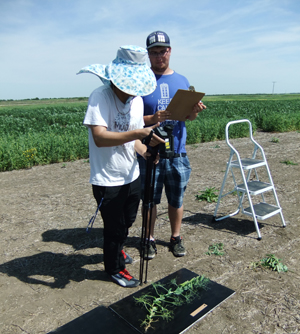USA
August 28, 2017
Source: CSSA
By Adityarup “Rup” Chakravorty
 Extreme heat has resulted in these pea blossoms not producing a pod. Photo credit Rosalind Bueckert.
Extreme heat has resulted in these pea blossoms not producing a pod. Photo credit Rosalind Bueckert.Farmers across the world produce between 10 and 13 million tons of field pea every year. That makes it a top legume crop, just behind dry beans and chickpeas.
But as the global climate changes and temperatures continue to rise, heat stress is becoming a major limiting factor for pea cultivation.
A new study indicates that pea plants with some specific traits – such as longer flowering time and higher pod numbers – may be more resistant to heat stress.
The researchers also gained new insights into the genetics of heat tolerance in pea.
“In some years, the older varieties of pea weren’t growing very well because of heat stress,” says Rosalind Bueckert, lead author of the study. “We wanted to find new varieties that have robust and consistent yields in a warming world.”
According to Bueckert, a plant scientist at the University of Saskatchewan, “tolerance to heat stress in peas seems to be dependent on quite a few traits.” The study found that two traits, however, are most important: higher pod numbers and longer flowering duration.
Bueckert and her colleagues Tom Warkentin and Shaoming Huang are the first to uncover the location of genes that affect heat stress.
“Heat stress means fewer flowers, fewer pods, and ultimately, lower yields,” says Bueckert. Varieties of pea that have more pods to begin with have higher yields after a heat-stress event.
Similarly, “if a pea variety flowers for a longer time, it has more opportunities to have a higher yield, even under heat stress,” says Bueckert. That’s because the plant has more time to recover from extreme weather events during flowering.
But too long of a flowering time can lead to other problems. “You need the right balance of the vegetative and reproductive phases,” says Bueckert.
To determine which traits are important for heat resistance in peas, Bueckert and her colleagues crossed two commonly used varieties of pea, CDC Centennial and CDC Sage. Then the researchers evaluated more than a hundred new varieties of pea derived from this cross.
“By crossing two different varieties of pea, you may be able to breed offspring with traits beyond those of either parent,” says Bueckert. For example, some of the offspring tested in this study were more heat-resistant than either CDC Sage or CDC Centennial.

Researchers check the effects of heat stress in pea using thermal images. Photo credit Brandon Louie.
The researchers cultivated these new varieties of pea for two growing seasons in Saskatchewan.
One batch was seeded at a typical time for pea cultivation, mid-May. A second batch was started in early June. These plants flowered later in the year when temperatures are higher. This allowed the researchers to test for pea varieties that grew better and had higher yields in warmer weather.
“Identifying traits that make pea plants more resistant to heat stress is one piece of the puzzle,” says Bueckert. The other piece is better understanding the genetics of these traits.
Traditionally, researchers used visible traits, such as pod number, to select crop varieties that grow well in specific environments. However, mapping out the pertinent genetic information helps focus the work. Researchers can identify specific genetic locations for a trait within the pea’s genetic map. From there, researchers can more reliably select crop varieties.
“The more work we can do with genetic locations and molecular techniques, the more efficient we will be,” says Bueckert.
While flowering duration and pod number are the two most important traits for heat resistance in peas, the researchers are also examining other traits that can contribute. For example, “semi-leafless varieties of pea are better at dealing with heat stress than leafy varieties,” says Bueckert.
Future research will aim to identify more of these traits, and further increase our understanding of the genetic basis of heat resistance in peas.
Read more about Bueckert’s research in Crop Science. The Natural Sciences and Engineering Research Council of Canada (NSERC) funded the research in partnership with money from two grower groups, Saskatchewan Pulse Growers Association and Western Grains Research Foundation.